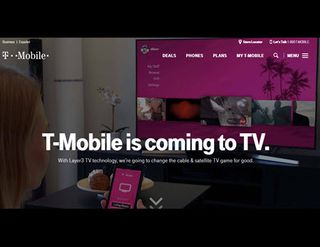T-Mobile Promises to Stir Up Pay TV Market

With the acquisition of Layer3 TV now complete, T-Mobile is preparing to do for pay TV what it’s been doing in wireless — shake things up.
How, precisely, T-Mobile will pull that off is the big question as it prepares to launch an over-the-top TV service later this year that will grapple with satellite, cable and telco TV providers as well as a growing array of virtual multichannel video programming distributors.
Related: Layer3 TV's Road to T-Mobile
T-Mobile did drop a few vague hints about what’s in store. For starters, T-Mobile won’t require its pay TV service subscribers to bundle in its mobile services, though it’s possible the company will offer incentives to consumers who do buy its video and mobile services together, and offer options that aren’t saddled with mobile data caps.
Really Going Over the Top
T-Mobile’s pay TV service will also be a true over-the-top offering, in that consumers will be able to access the service through any internet connection, and be able to buy it even in rural areas not covered by T-Mobile’s celluar network.
“We’re not going to give the world another metoo, copycat skinny bundle loaded with trade-offs,” Mike Sievert, T-Mobile’s chief operating officer, promised on a conference call soon after the deal was announced late last year.
An FAQ, posted soon after T-Mobile closed the Layer3 TV deal on Jan. 23, stressed that “[w]e don’t believe in carrier bundles where you’re forced to pay more for things you don’t want.” Interested consumers were also given the chance to register their contact information to receive an “exclusive offer” from T-Mobile.
T-Mobile has offered very little concrete information on how it will price and package the new video service and how it will separate from the pack of other OTT video services such as Sling TV, fuboTV, Philo, PlayStation Vue, YouTube TV, DirecTV Now and Hulu.
In addition to getting Layer3 TV’s technology and talent, T-Mobile is buying its distribution deals with networks and programmers. The question going forward is, how will it be able to create interesting or innovative national or local pay TV packages that adhere to the rights that Layer3 TV has been able to carve out.
Whatever T-Mobile comes up with, its packaging and pricing options will likely expand on and divert from Layer3 TV’s initial approach in cities where service is currently available: Los Angeles; Chicago; Washington, D.C.; Dallas-Fort Worth, Texas; and Longmont, Colo.
Layer3 TV has focused on an in-home, managed IPTV service featuring a cloud-based interface that drives a big bundle of pay TV programming, plus integrations with OTT offerings such as CuriosityStream, Pandora, Xumo, YouTube and iHeartRadio.
In Dallas, for example, the flagship Platinum allHD tier features more than 275 channels and a VOD library of 25,000-plus titles and starts at $75 per month.
As a differentiator, all of Layer3 TV’s set-top boxes (designed by a subsidiary of BMW Group called Designworks) are 4K-ready.
Layer3 TV has not announced subscriber numbers, but has tried some different marketing and deployment strategies. In addition to offering products directly to consumers, it has teamed with a municipal provider (NextLight in Longmont, Colo.) and offered a broadband bundle (using Verizon’s fiber network in Washington, D.C.).
Flanker Brand an Early Strategy
In its earlier days, Layer3 TV also kicked the tires on a flanker brand strategy, teaming with Suddenlink (now part of Altice USA) in Midland and Kingwood, Texas, to offer a service under the “Umio” name.
T-Mobile’s new TV team will be led by former Layer3 TV CEO Jeff Binder, now an executive VP at T-Mobile and part of the senior management team. Binder reports to Sievert.
T-Mobile said nearly 200 Layer3 TV employees have joined the company.
Multichannel Newsletter
The smarter way to stay on top of the multichannel video marketplace. Sign up below.
